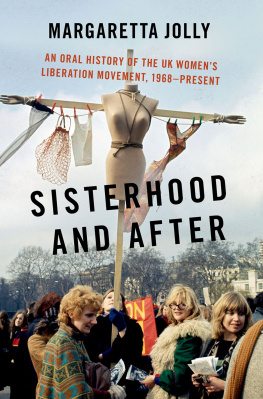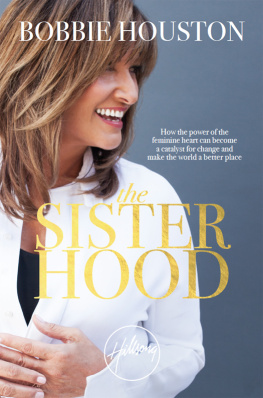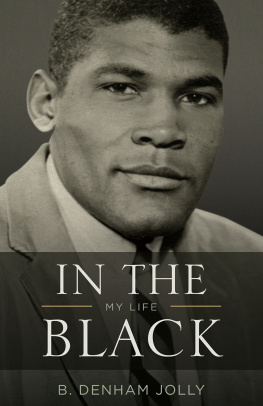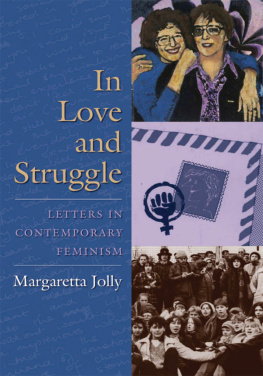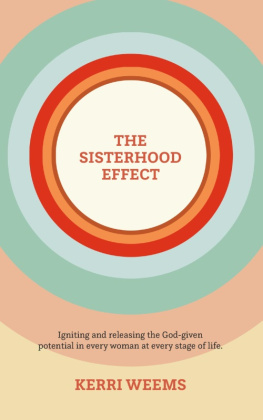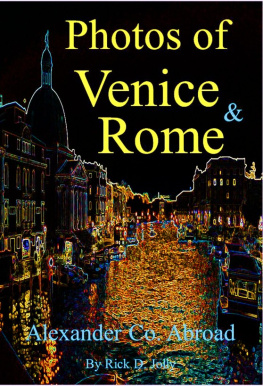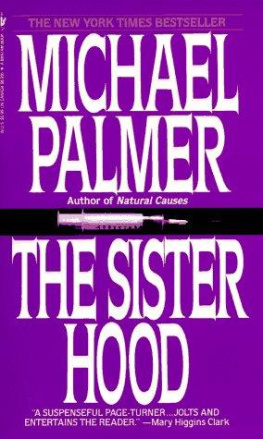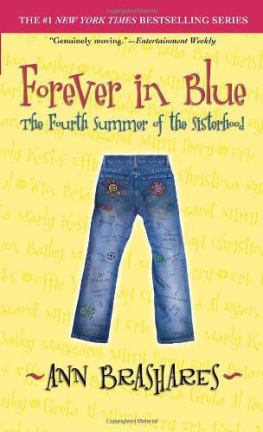Jolly Margaretta - Sisterhood and After
Here you can read online Jolly Margaretta - Sisterhood and After full text of the book (entire story) in english for free. Download pdf and epub, get meaning, cover and reviews about this ebook. year: 2019, publisher: Oxford University Press, Incorporated, genre: Politics. Description of the work, (preface) as well as reviews are available. Best literature library LitArk.com created for fans of good reading and offers a wide selection of genres:
Romance novel
Science fiction
Adventure
Detective
Science
History
Home and family
Prose
Art
Politics
Computer
Non-fiction
Religion
Business
Children
Humor
Choose a favorite category and find really read worthwhile books. Enjoy immersion in the world of imagination, feel the emotions of the characters or learn something new for yourself, make an fascinating discovery.
- Book:Sisterhood and After
- Author:
- Publisher:Oxford University Press, Incorporated
- Genre:
- Year:2019
- Rating:5 / 5
- Favourites:Add to favourites
- Your mark:
- 100
- 1
- 2
- 3
- 4
- 5
Sisterhood and After: summary, description and annotation
We offer to read an annotation, description, summary or preface (depends on what the author of the book "Sisterhood and After" wrote himself). If you haven't found the necessary information about the book — write in the comments, we will try to find it.
Sisterhood and After — read online for free the complete book (whole text) full work
Below is the text of the book, divided by pages. System saving the place of the last page read, allows you to conveniently read the book "Sisterhood and After" online for free, without having to search again every time where you left off. Put a bookmark, and you can go to the page where you finished reading at any time.
Font size:
Interval:
Bookmark:


Oxford University Press is a department of the University of Oxford. It furthers the Universitys objective of excellence in research, scholarship, and education by publishing worldwide. Oxford is a registered trade mark of Oxford University Press in the UK and certain other countries.
Published in the United States of America by Oxford University Press
198 Madison Avenue, New York, NY 10016, United States of America.
Oxford University Press 2019
All rights reserved. No part of this publication may be reproduced, stored in a retrieval system, or transmitted, in any form or by any means, without the prior permission in writing of Oxford University Press, or as expressly permitted by law, by license, or under terms agreed with the appropriate reproduction rights organization. Inquiries concerning reproduction outside the scope of the above should be sent to the Rights Department, Oxford University Press, at the address above.
You must not circulate this work in any other form and you must impose this same condition on any acquirer.
Library of Congress Cataloging-in-Publication Data
Names: Jolly, Margaretta, author.
Title: Sisterhood and after : an oral history of the UK womens liberation
movement, 1968present / Margaretta Jolly.
Description: New York, NY : Oxford University Press, [2019] |
Series: Oxford oral history series | Includes bibliographical references and index.
Identifiers: LCCN 2019000513 (print) | LCCN 2019004017 (ebook) |
ISBN 9780190658854 (Updf) | ISBN 9780190658861 (Epub) | ISBN 9780190658847 (hardcover)
Subjects: LCSH: FeminismGreat BritainHistory. | Feminists--Great BritainHistory.
Classification: LCC HQ1597 (ebook) | LCC HQ1597 .J65 2019 (print) | DDC 305.420941dc23
LC record available at https://lccn.loc.gov/2019000513
For Nick
Sally Alexander
Sisterhood and After offers us a new history of the womens liberation movement through the twentieth century and beyond. Margaretta Jollys deep listening to the oral archive focuses on feeling as well as the changing times of womens lives. Reading the book is an unnerving experience, since as one of the group behind the making of this archive, Im also one of the interviewed.
Womens liberation was a spontaneous, iconoclastic movement whose impulse and demands reached far beyond its estimated twenty thousand activists in the mid-1970s. Womens refuges, law centres, nurseries, rape crisis centres, publishing houses, magazines, journals, peace camps, and more were made in the name of all women, as were the fourby 1978 sevendemands. Inspired by civil rights, black power, national liberation movements, the utopianism of 1968, Britains movement followed close in the wake of industrial militancy among Ford seamstresses and Hull fishermens wives and families. The movements political touchstones were both revolution and democracy, the small group was its signature practice, and sexual difference was its foundational myth. Most women in the movement wanted a grassroots movement grounded in everyday life, as Sue OSullivan, a worker in womens health, puts it. Womens daily lives in Britainthen as nowwere significantly unequal and different.
Margaretta Jolly ventures deep into the hearts and minds of the sixty women interviewed in the Sisterhood and After Womens Liberation Oral History Project, whose oral life stories form the archive of feelingshame, guilt, anger, hope, loveon which her book is especially based. She tracks not one movement but many. Socialists, Marxists, lesbians, radical and revolutionary feminists, all of that was there, affirms Beatrix Campbell, journalist and author, recalling her own equivocal radical and socialist feminism. But Rosalind Delmar remembers the antagonism as women argued over the wording of the sixth demandthe right to define our own sexualityin Edinburgh in 1974. Sexuality and violencethe most difficult issues to bear consciously in mindevoked the strongest political memories among women interviewed.
Born around the Second World War, in the moment of reconstruction and Cold War, the womens liberation generation imbibed with their free milk, cod liver oil, secondary schools, and hospital clinics an audacitythe gift of previous generations determination to build a better world after fascism and world war. Envy and fear as well as love went into their makeup. Fathers returned from war, replacing the infant in her mothers bed, bringing with them the birth of siblings. Some recall domestic violence, their mothers (as well as their own) abortions, or silent depression. You can hear the intake of breath, Jolly notes, from almost all the interviewees when asked to speak about their mother. Fear of a third world war, palpable to a child who glimpsed or overheard, on radio or TV or in the Path News, stories of bloodshed in Palestine, India, Korea, or Suez, whose older brothers left for national service in postcolonial wars. Such memories resurfaced in the womens peace movements and camps of the 1970s and 1980s.
Womens liberation manifested these divisionslegacies of war, empire, and migrations. When Mukami McCrum, Scottish advocate for race and education rights, returned to visit family in Kenya, her mother noticed she had become sad and angry. Now Mukami always thinks about how she can avoid oppression taking root inside her, and she notices, too, the silent woman, makes a space for her, invites her to speak. Gail Lewis, a founding member of the Brixton Black Womens group and a sociologist and psychotherapist, describes her disappointment that the predominantly white womens liberation movement did not at first acknowledge the intellectual work of black UK feminists. Charting the Journey: Writings by Black and Third World Women (1988), she remembers, received more recognition in the United States than in the United Kingdom. Black and Asian British feminists took their own distinctive paths and made careful alliances with white women: for instance, the Grunwick strike (1976), the Southall Black Sisters (1979), the Organisation of Women of African and Asian Descent (1979), refuges from domestic violence in Edinburgh and Liverpool. Jolly maps the local and regional black and Asian womens groups that changed the face and mental climate of Britain.
The democratic voice of womens liberation emerged through conversation and small-group action. Catherine Hall, historianwhose story of a marriage forms one of the editorial gems in this bookcontrasts her isolation as a young mother with the fast friendships that emerged from consciousness raising. Stella Dadzie, writer and advocate of black womens rights, describes the spiritual and physical friendship another woman showed her in her time of deep mourning after the death of her mother. These and other instances established trust between women, the thinking in common (Virginia Woolfs phrase) that defended safe legal abortion and secured womens refuges, which today struggle to survive. After Margaret Thatchers election in 1979, feminists moved into municipal and national politics. The United Nations Declaration on the Elimination of Violence against Women in 1993, affirmed by the international gathering of women in Beijing two years later, testifies to their success. Harriet Harman, Labour member of Parliament since 1982, claims that the legalization of adoption rights for lesbian and gay parents and in-vitro fertilization rights (2002 and 2008, respectively), childcare, lone mothers right to work, and paternity leave fulfilled the early gender demands and body politics of the movement.
Font size:
Interval:
Bookmark:
Similar books «Sisterhood and After»
Look at similar books to Sisterhood and After. We have selected literature similar in name and meaning in the hope of providing readers with more options to find new, interesting, not yet read works.
Discussion, reviews of the book Sisterhood and After and just readers' own opinions. Leave your comments, write what you think about the work, its meaning or the main characters. Specify what exactly you liked and what you didn't like, and why you think so.

